
Bretton Hall is a country house in West Bretton near Wakefield, West Yorkshire, England. It housed Bretton Hall College from 1949 until 2001 and was a campus of the University of Leeds (2001–2007). It is a Grade II* listed building.

Lyme Park is a large estate south of Disley, Cheshire, England, managed by the National Trust and consisting of a mansion house surrounded by formal gardens and a deer park in the Peak District National Park. The house is the largest in Cheshire, and is recorded in the National Heritage List for England as a designated Grade I listed building.
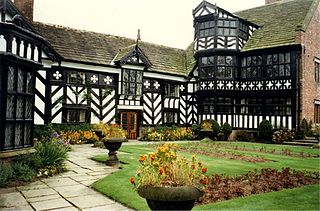
Gawsworth Old Hall is a Grade I listed country house in the village of Gawsworth, Cheshire, England. It is a timber-framed house in the Cheshire black-and-white style. The present house was built between 1480 and 1600, replacing an earlier Norman house. It was probably built as a courtyard house enclosing a quadrangle, but much of it has been demolished, leaving the house with a U-shaped plan. The present hall was owned originally by the Fitton family, and later by the Gerards, and then the Stanhopes. Since the 1930s it has been in the possession of the Richards family. Raymond Richards collected a number of items from other historic buildings and incorporated them into the hall.

Eaton Hall is the country house of the Duke of Westminster. It is 1 mile (2 km) south of the village of Eccleston, in Cheshire, England. The house is surrounded by its own formal gardens, parkland, farmland and woodland. The estate covers about 10,872 acres (4,400 ha).

Allostock is a village and civil parish in the unitary authority of Cheshire West and Chester and the ceremonial county of Cheshire, England, about five miles south of Knutsford and 20 miles south of Manchester. Allostock was formerly in the borough of Vale Royal until it was abolished on 1 April 2009 to form Cheshire West and Chester. Allostock is located on an affluent of the river Weaver. It had a population of 816 according to the 2011 census data as well as 325 households.
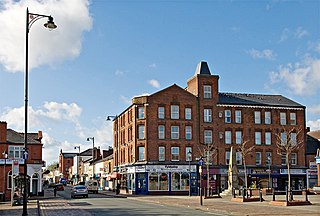
Tyldesley is a town in the Metropolitan Borough of Wigan in Greater Manchester, England. Within the boundaries of the historic county of Lancashire, it is north of Chat Moss near the foothills of the West Pennine Moors, 7.7 miles (12.4 km) southeast of Wigan and 8.9 miles (14.3 km) northwest of Manchester. At the United Kingdom Census 2001, the Tyldesley built-up area, excluding Shakerley, had a population of 16,142.
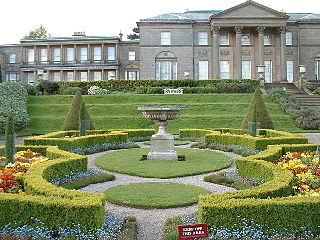
Tatton Park is an historic estate in Cheshire, England, north of the town of Knutsford. It contains a mansion, Tatton Hall, a medieval manor house, Tatton Old Hall, Tatton Park Gardens, a farm and a deer park of 2,000 acres (8.1 km2). It is a popular visitor attraction and hosts over a hundred events annually. The estate is owned by the National Trust, who administer it jointly with Cheshire East Council. Since 1999, it has hosted North West England's annual Royal Horticultural Society flower show.

Arrowe Park is an area 6.5 km (4.0 mi) to the west of Birkenhead, within the Metropolitan Borough of Wirral, Merseyside, England. It is situated on the Wirral Peninsula, adjacent to the Woodchurch housing estate and to the south of the large village of Upton. The location has two landmarks: Arrowe Park Hospital and Arrowe Country Park, along with a number of residences.
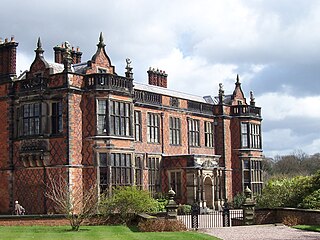
Arley Hall is a country house in the village of Arley, Cheshire, England, about 4 miles (6 km) south of Lymm and 5 miles (8 km) north of Northwich. It is home to the owner, Viscount Ashbrook, and his family. The house is a Grade II* listed building, as is its adjacent chapel. Formal gardens to the southwest of the hall are also listed as Grade II* on the National Register of Historic Parks and Gardens. In the grounds are more listed buildings, a cruck barn being listed as Grade I, and the other buildings as Grade II.

In the early 18th century the Oulton Estate was home to the Egerton family and comprised a manor house and a formal garden surrounded by farmland in Cheshire, England. Later in the century the farmland was converted into a park. The estate is now the site of the motor racing track called Oulton Park.

St Oswald's Church is in the village of Lower Peover, Cheshire, England. It is recorded in the National Heritage List for England as a designated Grade I listed building. It is an active Anglican parish church in the diocese of Chester, the archdeaconry of Macclesfield and the deanery of Knutsford. Its benefice is combined with that of St Lawrence, Over Peover.
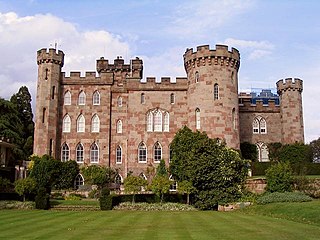
Cholmondeley Castle is a country house in the civil parish of Cholmondeley, Cheshire, England. Together with its adjacent formal gardens, it is surrounded by parkland. The site of the house has been a seat of the Cholmondeley family since the 12th century. The present house replaced a timber-framed hall nearby. It was built at the start of the 19th century for George Cholmondeley, 1st Marquess of Cholmondeley, who designed most of it himself in the form of a crenellated castle. After the death of the Marquess, the house was extended to designs by Robert Smirke to produce the building in its present form. The house is designated by English Heritage as a Grade II* listed building.
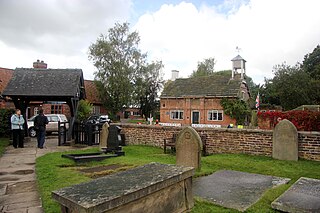
Peover Inferior is a civil parish in the Borough of Cheshire East and the ceremonial county of Cheshire, England. The village is known for its picturesque surrounding countryside and surprisingly convenient location. The name Peover is pronounced 'Peever' and derives from the Anglo-Saxon 'Peeffer' meaning 'a bright river', this 'bright river' being the River Peover which runs through the parish. The village and its neighbour Peover Superior lie on the river Peover, 'Inferior' here meaning downstream. The parish is situated on the B5081 roughly 25 km south south west of Manchester between Knutsford and Holmes Chapel and within five miles of junction 19 on the M6. Together with Nether Peover, it forms part of the village of Lower Peover, Lower Peover being the parish council. Peover Inferior is in Cheshire East, however Nether Peover is in Cheshire West, this often causes complications for the Lower Peover parish council. According to the 2011 census, it had a population of 220.
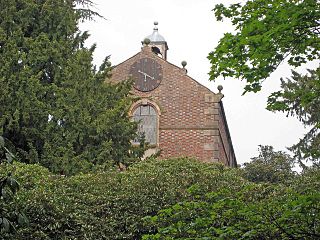
All Saints Chapel, Somerford is in an isolated position near the hamlet of Brereton Heath, between Congleton and Holmes Chapel, Cheshire, England. It is recorded in the National Heritage List for England as a designated Grade II* listed building. The chapel is in the Anglican benefice of Astbury and Smallwood in the deanery of Congleton, the archdeaconry of Macclesfield and the diocese of Chester.

Somerford is a civil parish in the unitary authority of Cheshire East and the ceremonial county of Cheshire, England. It is adjacent to the north west of Congleton, from which town it has some housing overflow. According to the 2001 census, the population of the civil parish was 343, increasing to 430 at the 2011 Census.
Ashbourne Hall is a Manor house originally built by the Cockayne family in the 13th century in Ashbourne, Derbyshire. The present building is part of a largely demolished, Georgian-styled hall built in the 18th century.
Alderley Old Hall is the remaining part of a former 17th-century manor house near the village of Nether Alderley, Cheshire, England. It stands adjacent to the mill pond of Nether Alderley Mill, a loop of which acts as a moat. The hall is recorded in the National Heritage List for England as a designated Grade II* listed building.

Toft Hall is a 17th-century country house in Toft, Cheshire, England to which additions and alterations have been made during the following three centuries.

Hulme Hall is a house on a moated site in the parish of Allostock, Cheshire, England. It originated in the 15th century, with additions and alterations in the 17th and 19th centuries. It is now a farmhouse. The house is constructed in brown brick, and has a roof of stone-slate and Welsh slate. It is in two storeys with an attic, and has an asymmetrical plan. The northeast front is the entrance front, and has three gabled bays. The garden front is on the northwest; it has five bays, two of which are stepped back in two stages. Most of the windows are two or three-light casements. The house is recorded in the National Heritage List for England as a designated Grade II* listed building. The bridge over the moat leading to the house is also listed at Grade II*. The moated site on which the house stands is a scheduled monument. It had been the home of the Grosvenor and Shakerley families, both of whom were prominent in Cheshire.
Orford Hall, now demolished, was a 17th-century country house built in an estate which is now a public park in Orford, Warrington, England.

















